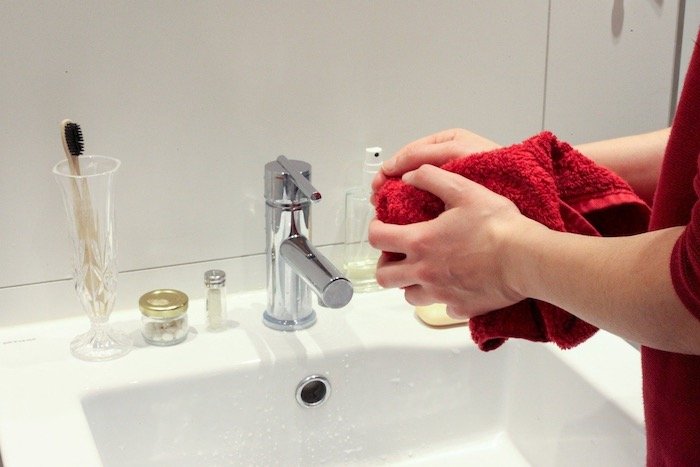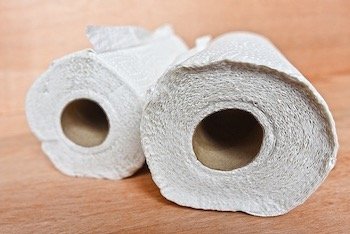
You’ve probably noticed that drying hands more often leads to dry hands.
Ever since the COVID-19 pandemic hit, we’ve all been washing our hands a lot more than usual.
That means we’re drying hands more often too, and over time, that can cause our hands to turn dry, flaky, chapped, dull. They may even develop ugly calluses or open cracks and sores.
We’re here to help. Check out our tips for how to keep your hands soft and smooth.
Using Air Dryers When Drying Hands Leads to Dirtier Hands!
Over the past several years, we saw a lot of restrooms switch from supplying paper towels to installing air dryers instead.
It seemed like a great idea. Air dryers cost less money over the long-term, create less waste, and still do the job of drying your hands (though they take a little longer).
Many people also thought that air dryers were more hygienic too. After all, there were none of those dirty paper towels lying around.
But then some new studies came out showing that theory to be flat-out wrong.
In a 2012 study, researchers concerned about the proper hand-drying process reviewed data from 12 studies and found that paper towels “can dry hands efficiently, remove bacteria effectively, and cause less contamination of the washroom environment” than air dryers.
They went on to notes that from a hygiene standpoint, paper towels were superior to electric air dryers.
 Paper Towels Are the Best Thing to Use when Drying Hands
Paper Towels Are the Best Thing to Use when Drying Hands
When the COVID-19 pandemic hit, researchers again wondered which method (paper towels or air dryers) might be better at helping to reduce the spread of the illness.
In 2021, scientists published a study in which they examined virus transmission in the hospital environment following hand drying. The participants used 3-5 paper towels for an average of 12 seconds or dried their hands with a jet air dryer for about 10 seconds. Then the scientists checked for germs on their hands and on an apron they wore.
The results showed that both the jet air dryer and the paper towel significantly reduced bacteria contamination on the hands, but that the contamination on the apron was much higher after using the jet air dryer.
In other words, the jet air dryer blew the germs from the participants’ hands onto the front of their bodies, where they could then cross-contaminate other surfaces. Indeed, the scientists found that for all samples, there was a significantly higher level of surface contamination following hand drying with the jet air dryer than with the paper towels.
This was only one study and it was a small one, but there have been others suggesting the same thing. In 2018, for instance, researchers tested the bacteria spread by hot-air hand dryers and found that many kinds of bacteria, including potential pathogens and spores, could be deposited on hands exposed to these dryers. Further, the spores could be dispersed throughout the building.
Bottom line: when possible, use paper towels to dry your hands. Of course, when you can, choose 100 percent recycled, non-toxic, biodegradable versions.
Drying Hands Creates Dry, Chapped Hands
While we’re doing all this handwashing and trying to avoid germs, our hands are taking a beating.
The outermost layer of the skin is composed of oils and wax that protect us from germs and toxins while trapping and holding moisture in the skin.
This natural barrier is broken down every time we apply soap and suds up our hands. That soap gets rid of unwanted germs, grime, and debris, but it also breaks down the natural oils and strips them away.
If you’re not careful to address these issues after washing, your hands will soon become dry, red, cracked, and painful. If you already have a preexisting skin condition like eczema or psoriasis, your symptoms may be worse.
Handwashing and Drying Hands Tips to Avoid Germs and Keep Hands Soft
We need to regularly wash and dry our hands to keep ourselves healthy, but we also want to avoid dry, chapped hands.
To do that, follow these tips:
1. Use a gentle cleanser.
You may not always have access to your own cleanser, but as often as you can, choose a cream-based brand that is made without fragrances, harsh chemicals, and sulfates. These will irritate the skin further and make it more difficult to maintain soft, smooth hands. Look for one with gentle detergents and moisturizing ingredients.
2. Wash with warm, not hot water.
Hot water is a lot better at stripping away oil than warm or lukewarm water, and all of them work equally well at killing germs. So dial the temperature down.
3. Wash for at least 20 seconds.
Soap and water need time to eradicate any germs, so take a deep breath and relax. Most of us hurry through washing our hands, but that can leave more germs behind than you may expect.
4. Pat dry with a towel.
Sometimes you won’t have access to a towel, but whenever you can, choose the towel over the air dryer. In some cases, you could take napkins with you into the restroom and use those to dry your hands.
Then pat—don’t rub—dry. This helps to avoid disrupting that outer barrier further, and also leaves a little water on your skin, which is best for the next step.
 5. Apply a moisturizer immediately.
5. Apply a moisturizer immediately.
This is the step most people miss when washing their hands. That’s why we recommend you take our travel-size Calming Moisture or Body Repair Lotion with you wherever you go. Apply it right after you dry your hands.
This will help that outer layer recover the moisture it just lost, and will also add a layer of protection to your skin. It is the best way to avoid chapped, cracked skin. Apply, apply, apply!
Whatever moisturizer you use, avoid those with petrolatum, fragrances, alcohols, and other harsh ingredients. These will not provide adequate moisture.
If you have no way to wash your hands and you want to use a hand sanitizer, apply your moisturizer immediately after the sanitizer dries. The Centers for Disease Control and Prevention (CDC) recommends using a hand sanitizer that contains at least 60 percent alcohol to kill germs, and alcohol is very drying.
6. Use a moisturizing balm overnight.
Particularly during cold and flu season when you’re washing your hands more often, it helps to apply a deeply moisturizing balm overnight.
We suggest our Restorative Skin Balm. It helps to trap moisture while promoting healing and softening dry, rough skin. After washing and patting dry, apply it all over your hands, then don’t get your hands wet again until the next morning. For more moisturization, wear a soft pair of cotton gloves or even socks to bed to seal in the moisture.
7. Use a humidifier overnight.
If you live in a dry climate, a humidifier is a good thing to have in your bedroom. It will moisturize the air overnight while you sleep, which will keep your hands from drying out. This is good for the skin on your face as well!
Have you heard that drying hands with a warm-air dryer can spread germs?

